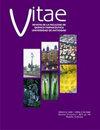Antioxidant and Inhibitory Capacity of Tomato Leaf Ethanolic Extract against Streptococcus mutans, Porphyromonas gingivalis, and Candida albicans
Q3 Pharmacology, Toxicology and Pharmaceutics
引用次数: 1
Abstract
Background: Tomato is a source of bioactive compounds, antimicrobials, and antioxidants. Tomato leaf preparations have been empirically used for anti-inflammatory, analgesic, antibiotic, and antiseptic purposes. However, research on the potential activity of tomato leaf extracts against oral microorganisms and in managing oropharyngeal infections is scarce. Objective: To investigate tomato leaf ethanolic extract’s antioxidant and growth inhibitory capacity against common oral pathogenic microorganisms, namely, Streptococcus mutans, Porphyromonas gingivalis, and Candida albicans. Methods: Ethanolic extracts were made from ‘Chonto’ tomato (Lycopersicon esculentum) leaves. The antimicrobial activity was measured with the microdilution technique using vancomycin and fluconazole as positive controls. The antioxidant capacity was measured with the ORAC assay using Trolox as a positive control. Results: We found a high percentage of growth inhibition (≥100%) against S. mutans and P. gingivalis at a concentration of 500 mg/L. However, the extract was ineffective in inhibiting the growth of C. albicans. Finally, we observed that the extract exerted a high antioxidant capacity (126%) compared to the positive control. Conclusions: This study provides new insights into the potential antimicrobial effect of tomato leaf extracts on common oral pathogenic bacteria, which may ultimately result in the development of new herbal products that might help prevent and treat oral infections, such as dental caries and periodontal disease. Our findings also support previous studies on the high antioxidant capacity of tomato leaf extracts.番茄叶乙醇提取物对变形链球菌、牙龈卟啉单胞菌和白色念珠菌的抗氧化和抑制作用
背景:番茄是生物活性化合物、抗菌剂和抗氧化剂的来源。番茄叶制剂已被经验地用于抗炎,镇痛,抗生素和防腐目的。然而,关于番茄叶提取物抗口腔微生物和治疗口咽感染的潜在活性的研究很少。目的:研究番茄叶乙醇提取物对口腔常见病原菌变形链球菌、牙龈卟啉单胞菌和白色念珠菌的抗氧化和生长抑制作用。方法:以“春冬”番茄(Lycopersicon esculentum)叶片为原料,提取乙醇提取物。以万古霉素和氟康唑为阳性对照,采用微量稀释法测定其抑菌活性。以Trolox为阳性对照,用ORAC法测定抗氧化能力。结果:在500mg /L浓度下,对变形链球菌和牙龈卟啉卟啉菌有较高的生长抑制率(≥100%)。然而,提取物对白色念珠菌的生长没有抑制作用。最后,我们观察到,与阳性对照相比,提取物具有较高的抗氧化能力(126%)。结论:本研究为番茄叶提取物对常见口腔致病菌的潜在抗菌作用提供了新的见解,这可能最终导致新的草药产品的开发,可能有助于预防和治疗口腔感染,如龋齿和牙周病。我们的发现也支持了先前关于番茄叶提取物具有高抗氧化能力的研究。
本文章由计算机程序翻译,如有差异,请以英文原文为准。
求助全文
约1分钟内获得全文
求助全文
来源期刊

Vitae
PHARMACOLOGY & PHARMACY-
CiteScore
1.20
自引率
0.00%
发文量
0
审稿时长
>12 weeks
期刊介绍:
The journal VITAE is the four-monthly official publication of the School of Pharmaceutical and Food Sciences, and its mission is the diffusion of the scientific and investigative knowledge in the various fields of pharmaceutical and food research, and their related industries. The Journal VITAE is an open-access journal that publishes original and unpublished manuscripts, which are selected by the Editorial Board and then peer-reviewed. The editorial pages express the opinion of the Faculty regarding the various topics of interest. The judgments, opinions, and points of view expressed in the published articles are the responsibility of their authors.
 求助内容:
求助内容: 应助结果提醒方式:
应助结果提醒方式:


